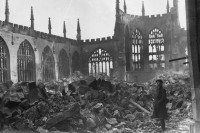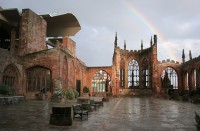For the first time since Luftwaffe all but destroyed the medieval city of Coventry in the Second World War, the original floor of the Gothic cathedral of St. Michael’s has been revealed.
 Coventry, an important industrial center that manufactured everything from bicycles to munitions, was the target of many bombing raids during the Battle of Britain, the most damaging of which struck on November 14th, 1940. German bombers dropped 500 tons of high explosive devices, intended to destroy infrastructure like water mains and roads, and 36,000 incendiary bombs, intended to burn down industrial targets (and pretty much everything else) in the city center.
Coventry, an important industrial center that manufactured everything from bicycles to munitions, was the target of many bombing raids during the Battle of Britain, the most damaging of which struck on November 14th, 1940. German bombers dropped 500 tons of high explosive devices, intended to destroy infrastructure like water mains and roads, and 36,000 incendiary bombs, intended to burn down industrial targets (and pretty much everything else) in the city center.
St. Michael’s suffered multiple direct hits from incendiary bombs. Volunteer Firefighters were only able to put out the first of the fires before finding themselves overwhelmed by the inferno raging all over the Coventry’s historic center. The Cathedral was soon engulfed in flame. When the dust settled the next morning, St. Michael’s was a smoldering ruin, only the tower, spire and outer wall still standing on the scorched pavement. Thankfully the precious Gothic stained glass windows had been removed in 1939 to spare them from just this fate and have survived to this day.
 After the war, a new cathedral was built next to what was left of the old one. Because the ruins of the medieval cathedral were exposed to the elements, the original floor was covered with rubble and concrete and topped with flagstones. Because it had been so pitted and scarred by the bombing and fire, the new pavement varied in depth from 50 centimeters (20 inches) to a meter (3’3″). In 1955 the ruins were added to England’s National Heritage List with a Grade I designation.
After the war, a new cathedral was built next to what was left of the old one. Because the ruins of the medieval cathedral were exposed to the elements, the original floor was covered with rubble and concrete and topped with flagstones. Because it had been so pitted and scarred by the bombing and fire, the new pavement varied in depth from 50 centimeters (20 inches) to a meter (3’3″). In 1955 the ruins were added to England’s National Heritage List with a Grade I designation.
Listed structures cannot be altered without special permission, permission that was granted to the ruins of St. Michael’s because the floor is in danger from water damage. A new watertight membrane and drainage system will ensure the original floor doesn’t crumble underneath the mid-century concrete and pavers. The first step in the process was to lift the post-World War II flooring to expose the floor as it was before the bombs fell.
 Although the church was built in the 14th century, much of the floor that has been uncovered consists of memorial stones laid down in the 18th century and later. The wooden base of the choir stalls were also found, carbonized by the fires.
Although the church was built in the 14th century, much of the floor that has been uncovered consists of memorial stones laid down in the 18th century and later. The wooden base of the choir stalls were also found, carbonized by the fires.
Also uncovered is a wall of the 13th century Chapel of the Blessed Virgin Mary by the cemetery. While archaeologists expected to find parts of it, they can now confirm that it was a two storey building – the top floor of which was removed as the cathedral was expanded over it.
The cathedral team had hoped to discover a third concealed crypt similar to the Wyley Chapel. Although no crypt was discovered, there was a small space containing rubble from the interior of the ruined cathedral. Most of it was broken down after World War Two and the carved masonry is seen as a ‘time capsule’ of stonework from the time.
If you’d like to see the parts of Coventry Cathedral that have been hidden for 60 years or so, the project’s lead archaeologist will give two half-hour talks in the ruins, the first on Wednesday, July 15th, the second on Friday, July 17th, both from 1:00-1:30 PM. If there’s enough interest from visitors, the Cathedral will host more such events.